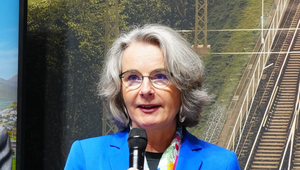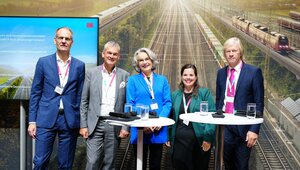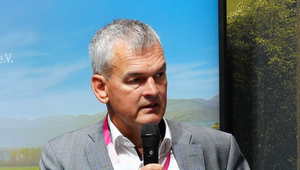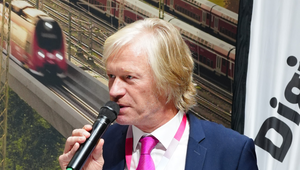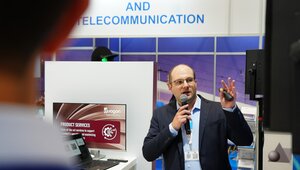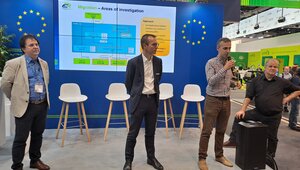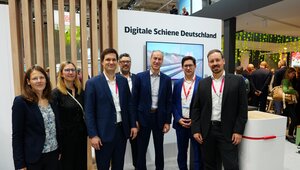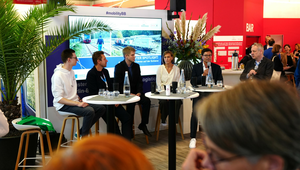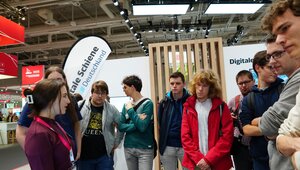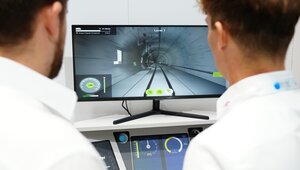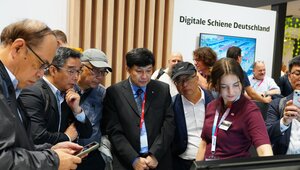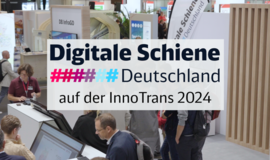
InnoTrans 2024: "The Future of Mobility" meets "The Future of Railway" - all signs point to digitalisation
The InnoTrans 2024 is over, and it is obvious: digitalisation is not only the focus of Digitale Schiene Deutschland (DSD) but also part of the entire industry. The European Train Control System (ETCS) and Automatic Train Operation (ATO) were hot topics on all agendas.
The DSD team has successfully concluded four successful days at the trade fair, once again representing itself at the DB booth this year. The interactive touch application attracted numerous interested visitors to learn more about the future digital rail system. The stand crew had intensive and exciting discussions about DSD's infrastructure- and pilot- and development projects with many visitors. The driving simulator was a major attraction at the booth: The simulator provided an insight into how train journeys operate using European train control system (ETCS) and ATO technology. However, it is not just a simple simulation; visitors were able to test their skills as a train driver at various difficulty levels to achieve the highest score.
As at the previous InnoTrans in 2022, Digitale Schiene Deutschland offered a varied program, featuring three Mobility Talks and a panel discussion at the DB booth. Moreover, the DSD-colleagues presented their expertise at various partner booths.
The panel discussion with Susanne Henckel, State Secretary at the German Federal Ministry for Digitalisation and Transport, Axel Schuppe, Managing Director of the German Railway Industry Association, Jan Görnemann, Spokesperson of the Board of Managing Directors of Bundesverband SchienenNahverkehr e.V. and Dr Volker Hentschel, Board Representative for Digitale Schiene Deutschland at DB InfraGO AG, provided an insight into the digital future of local rail passenger transport. The speakers discussed examples such as the automated driving of the Nuremberg underground– Germany’s first fully automated underground. The Digital S-Bahn Hamburg is also ahead of its time: starting, accelerating, braking and stopping - the highly automated trains take care of this all by themselves.
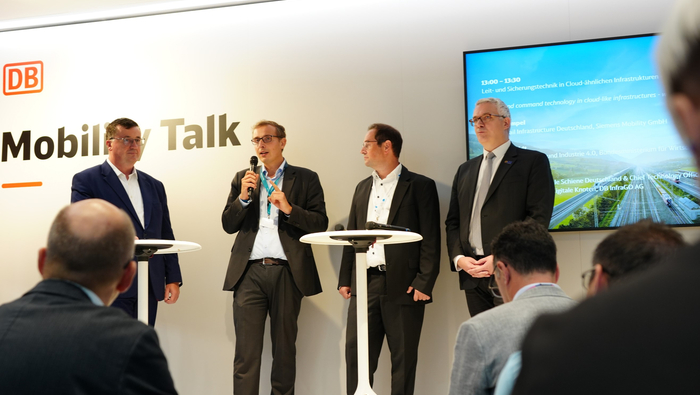
In the first Mobility Talk, Dr Kristian Weiland, Head of Development Digitale Schiene Deutschland and CTO DB InfraGO AG, Dr Guido Rumpel, Head of Rail Infrastructure Germany at Siemens Mobility, Dr Reinhard Hametner, Head of Global Development Competence Centre "Transvital Platform" at Hitachi Rail GTS Deutschland GmbH and Marco Schuldt from Division Digitalisation and Industry 4.0 of the German Federal Ministry for Economic Affairs and Climate Action, discussed when rail operations in the cloud will become reality. As seen in other mobility sectors, there is a trend towards cloud and edge technologies in railway systems – e.g. for better cost efficiency, scalability and maintainability. The Cloud4Rail project offers the European rail sector a standardised approach and is already being tested. It could be ready for implementation in just a few years.

The second Mobility Talk dealt with the practicability of Digitale Schiene Deutschland, with a focus on current realisation projects. Dr Volker Hentschel engaged in a discussion with Markus Fritz, Managing Director / Chief Operating Officer at Hitachi Rail GTS Deutschland GmbH and Steffen Saremba, Head of Development & Projects, agent holding a full power of attorney & member of the management board at PINTSCH GmbH, about how the sector can collaborate to digitalise the railway system. They agreed that old interlocking technologies and national train control systems must be replaced by digital and standardised technologies in the near future. However, the development of these new technologies presents significant challenges, as all three speakers emphasised. For a successful implementation, the industry requires adequat financial resources from the start of the project, qualified personnel and sufficient building materials. Additionally, processes need to become more efficient, as only leaner workflows can guarantee faster project realisation. Everyone agrees that the upcoming challenges must and can only be solved together in a partnership between politics, industry and Deutsche Bahn.
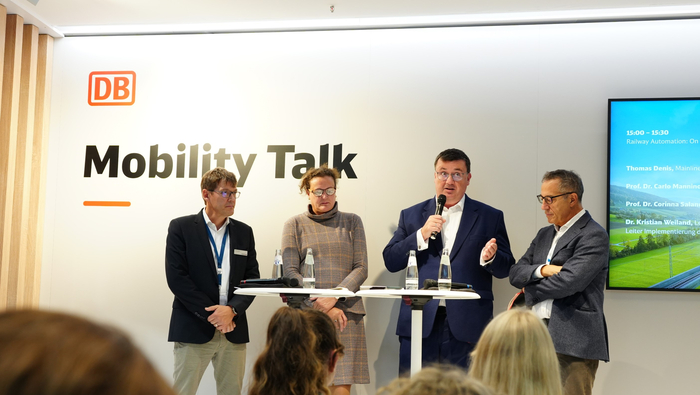
The third Mobility Talk highlighted the fact that Digitale Schiene Deutschland is a pioneering force for the entire sector. Innovations such as ATO or intelligent traffic management systems (TMS) were just mere concepts on the drawing board a few years ago. The industry now has these products in its portfolio, with many already in use in other countries. In many areas the step from development to operational use is already possible. The German railway sector is now challenged to implement digital technologies and efficient automation in railway operations: Dr Kristian Weiland, Prof Dr Corinna Salander, Head of the Rail Transport Department at the Federal Ministry for Digitalisation and Transport, Thomas Denis, Vice President Mainline Signalling at ALSTOM SA and Prof Dr Carlo Mannino, Senior Scientist in the Department of Mathematics and Cybernetics at SINTEF DIGITAL, discussed this path.
Exciting discussions were not only held at the Deutsche Bahn stand. Many visitors of Digitale Schiene Deutschland also made their way to the Europe's Rail (ERJU) stand. Interested pindividuals were able to find out more about how the Single European Railway Area (SERA), proclaimed by the European Union, is becoming a reality. This is exactly what "Europe's Rail" represents: In the “System Pillar” architecture and development planning is elaborated, while the associated technological innovations and their initial applications are planned in the "Innovation Pillar". Together with EUG representative Renato Rodrigues and Udo Golebniak from Siemens Mobility, our colleague Roman Treydel talked about the status of harmonisation of control and signalling technology in their presentation "Command, Control, Signalling - What is the target?". Additionally, our colleagues Dr Werner Ried, Sebastian Post, Jens Albrecht and Simon Söser presented the Digital Rulebook (Ril400) daily, explaining how European rail operations can be standardised more effectively. The nationwide rollout of ETCS Level 2 makes it possible to rethink core processes and harmonise the operational regulations of the member states.
The discussion at the joint booth of Berlin-Brandenburg focused on projects relating to automated driving in the region Berlin and Brandenburg. Our colleague Dr Danny Kreyenberg was invited as a guestspeaker and presented the laboratory and field tests of Digitale Schiene Deutschland at the Havelländische Eisenbahn AG test site in Berlin-Spandau. The focus was the practical testing of an innovative obstacle detection system that Siemens Mobility has installed in one of the latest trains of the Berlin S-Bahn. The Digitale Schiene Deutschland contributed the Digital Register, a digital map of infrastructure data, and the corresponding open data platform.
The joint presentation by colleagues Maik Fox and Florian Reiniger with duagon AG focused on innovative computing platforms for fully automated driving on the track site which are part of the project “Automated Train” Together with nine partners, the project is developing and testing the fully automated preparation and shutdown of trains. In addition, driverless driving is being piloted for fully automated dispatching and stabeling operations with the aim of enabling flexible deployment of trains on the network.
DSD also hosted political guests at the booth: Stefan Heidemann (Department Digitalisation, Industry 4.0), responsible for the funding program "New Vehicle and System Technologies" of the German Federal Ministry for Economic Affairs and Climate Action (BMWK), discussed topics such as (fully) automated (GoA2 & GoA4) driving in the railway sector and Deutsche Bahn's role in its development in greater depth with the DSD team.
Many thanks to everyone who contributed to the success of this fair!
